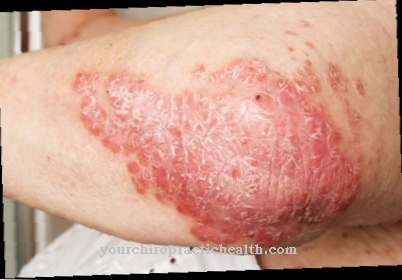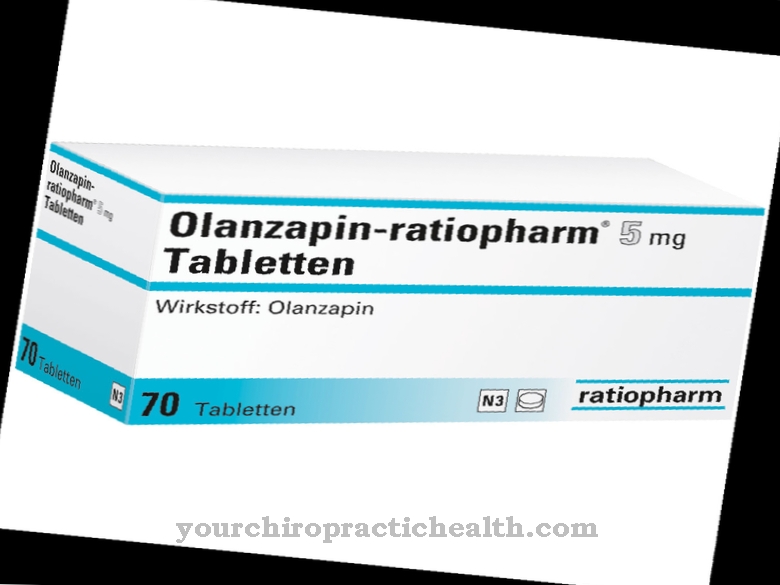Reserpine is a drug used as an antihypertensive and neuroleptic. The active ingredient originally comes from some plants from the snake root group.
What is reserpine?

Reserpine is a chemical compound that occurs naturally in plants. The substance belongs to the indole alkaloids. Indole alkaloids are the largest group within the alkaloids. They are characterized by their indole or indoline base.
The drug reserpine became known in western medicine, in particular through the plant Rauvolfia serpentina from India. Reserpine was one of the drugs that ushered in the era of modern psychomedication. The substance was initially used in psychiatric facilities for schizophrenia as a neuroleptic. Neuroleptics are now also known as antipsychotics. These are drugs that have an antipsychotic and / or sedative effect.
Later reserpine was mainly used as a remedy for high blood pressure (hypertension). Today, due to various side effects, reserpine is neither a neuroleptic nor an antihypertensive agent of first choice.
Pharmacological effect
The effect of reserpine in the human body can be divided into a central and a peripheral effect. Reserpine inhibits the neurotransmitter noradrenaline in the sympathetic nervous system. The postganglionic system is particularly affected. Although more nerve cells discharge due to the depletion of the neurotransmitter than before the drug was taken, the stimulus is not transmitted to the periphery of the body. By inhibiting the sympathetic nervous system, the heart rate is lowered and thus the blood pressure is lowered accordingly.
At the same time, reserpine lowers the dopamine and serotonin concentrations in the central nervous system. At the cellular level, reserpine also empties the stores of biogenic amines. These include neurotransmitters like serotonin, dopamine, and norepinephrine. In addition, the neurotransmitters can no longer be absorbed into the cell via the vesicles. These mechanisms of action lead to the antipsychotic and sedative effects of reserpine.
Medical application & use
Reserpine was first isolated from the Rauvolfia serpentina plant in 1952. While the drug was often used as an antihypertensive and neuroleptic in the 1950s, 1960s and 1970s, reserpine is rarely found in drugs today. The substance has been replaced by more effective drugs with fewer side effects. Reserpine is now only available on the market in pharmacologically relevant quantities as a component of diuretics. Reserpine is combined with thiazide diuretics, dihydralazine and hydrochlorothiazide. However, the frequency of prescribing these remaining preparations with reserpine also decreases. There is also currently a homeopathic preparation on the market that contains reserpine as a pure substance with a potency of D3 32 milligrams.
Reserpine can also be used diagnostically. The drug is sometimes used if a carcinoid is suspected. Carcinoids are neuroendocrine tumors that produce tissue hormones such as kallikrein and serotonin. The reserpine test is a provocation test. Carcinoids usually produce large amounts of serotonin. Reserpine ensures the release of the serotonin from the tumor cells, so that the typical symptoms of the carcinoid become more pronounced after the reserpine administration. In addition, there is a greatly increased concentration of 5-HIES in the urine. 5-HIES is a breakdown product of serotonin.
Risks & side effects
Reserpine has fallen into disrepute primarily because of its serious side effects. Reserpine lowers the availability of catecholamines and thus lowers the sympathetic tone. Acetylcholine, another neurotransmitter, remains unaffected by this effect, so that the activity of the parasympathetic nervous system predominates as a result of drug intake. This can lead to constriction of the pupils, sagging lids and swelling of the nasal mucous membranes. This phenomenon is also known as reserpine runny nose.
Other side effects caused by the increased activity of the parasympathetic nervous system include loss of potency and libido and diarrhea. It can lead to stomach and intestinal ulcers. In addition to the desired bradycardia, a positional drop in blood pressure can also occur. This orthostatic hypotension can be so severe that those affected lose consciousness if they stand up quickly.
Reserpine can damage unborn and newborn babies through breast milk and the placenta. If mothers took reserpine in the last trimester of their pregnancy, the children suffer significantly more often from breathing and drinking disorders after birth. Newborns often show pronounced lethargy. The fetus may have a slow heartbeat. Reserpine can also cause menstrual cramps in women.
In the central nervous system, the side effects arise mainly from the lack of serotonin and dopamine. So-called extrapyramidal motor disorders and parkinsonism develop with symptoms such as rigid muscles, immobility, muscle tremors and postural instability.
When reserpine is overdosed, blood pressure, heart rate and body temperature all drop rapidly. Those affected suffer from severe drowsiness. Cramps may also occur.
It should be noted that prior administration of tricyclic or tetracyclic antidepressants causes a so-called reserpine reversal. The motor excitation is not inhibited as intended, but increased. Indirect sympathomimetics do not work when pretreated with reserpine. In contrast, the lowering effect of antidiabetic drugs on the blood sugar level is increased by reserpine. The effectiveness of anti-Parkinson drugs such as levodopa or bromocriptine is disturbed. Patients who take cardiac active glycosides and reserpine at the same time can develop irregular heartbeats.
Reserpine is contraindicated in the case of a history of depressive episodes, existing gastric and duodenal ulcers, and bronchial asthma.



























